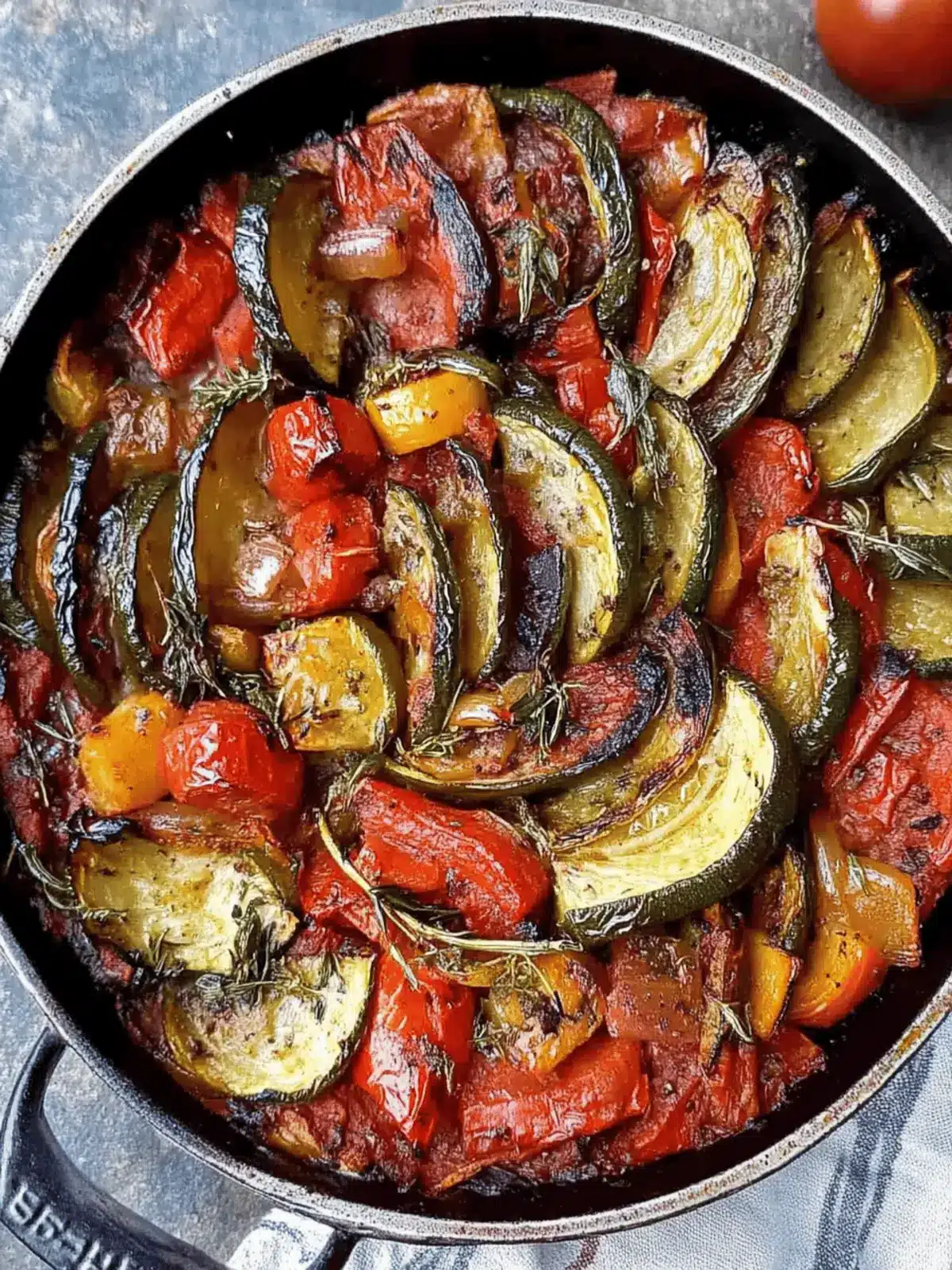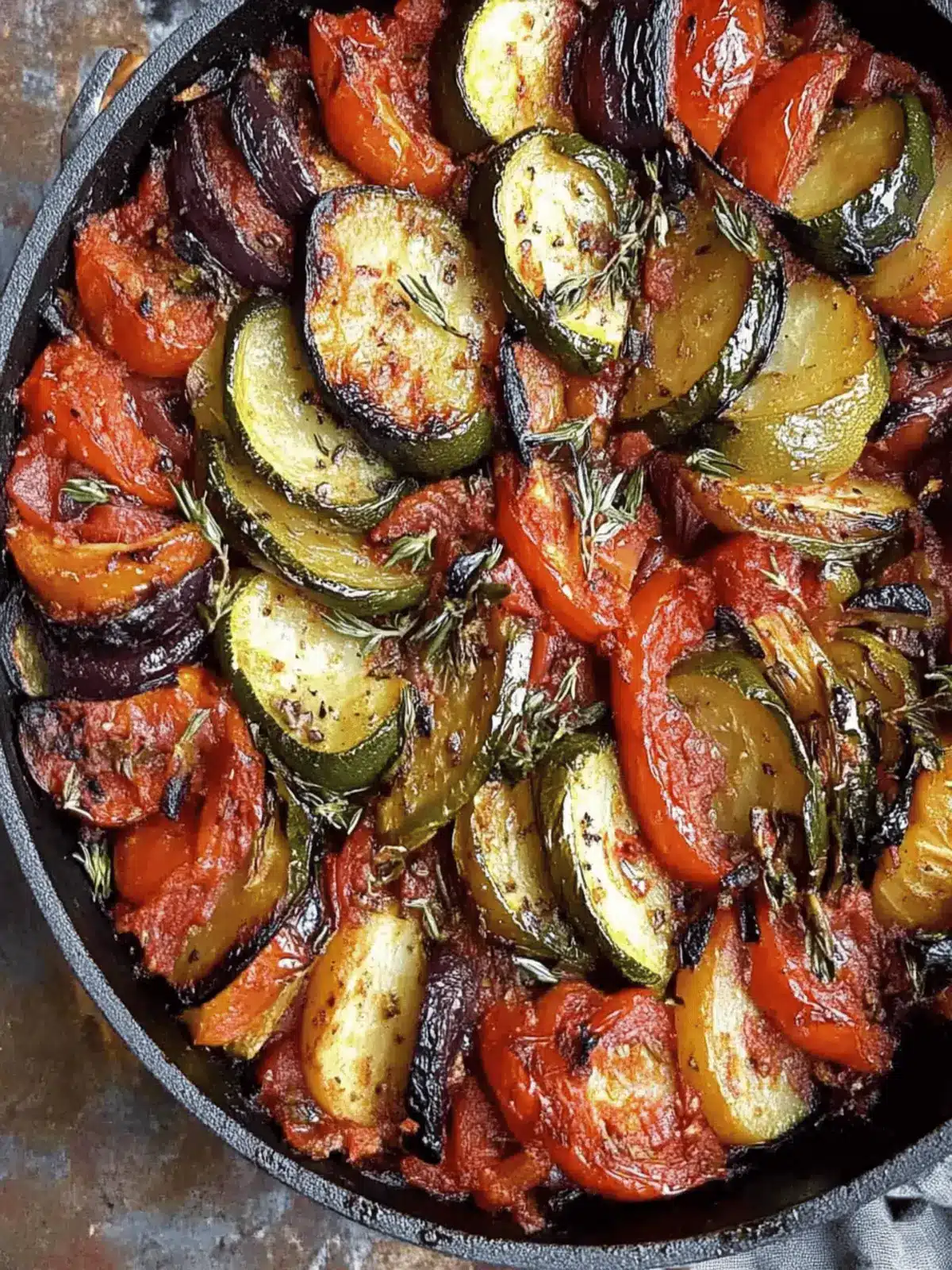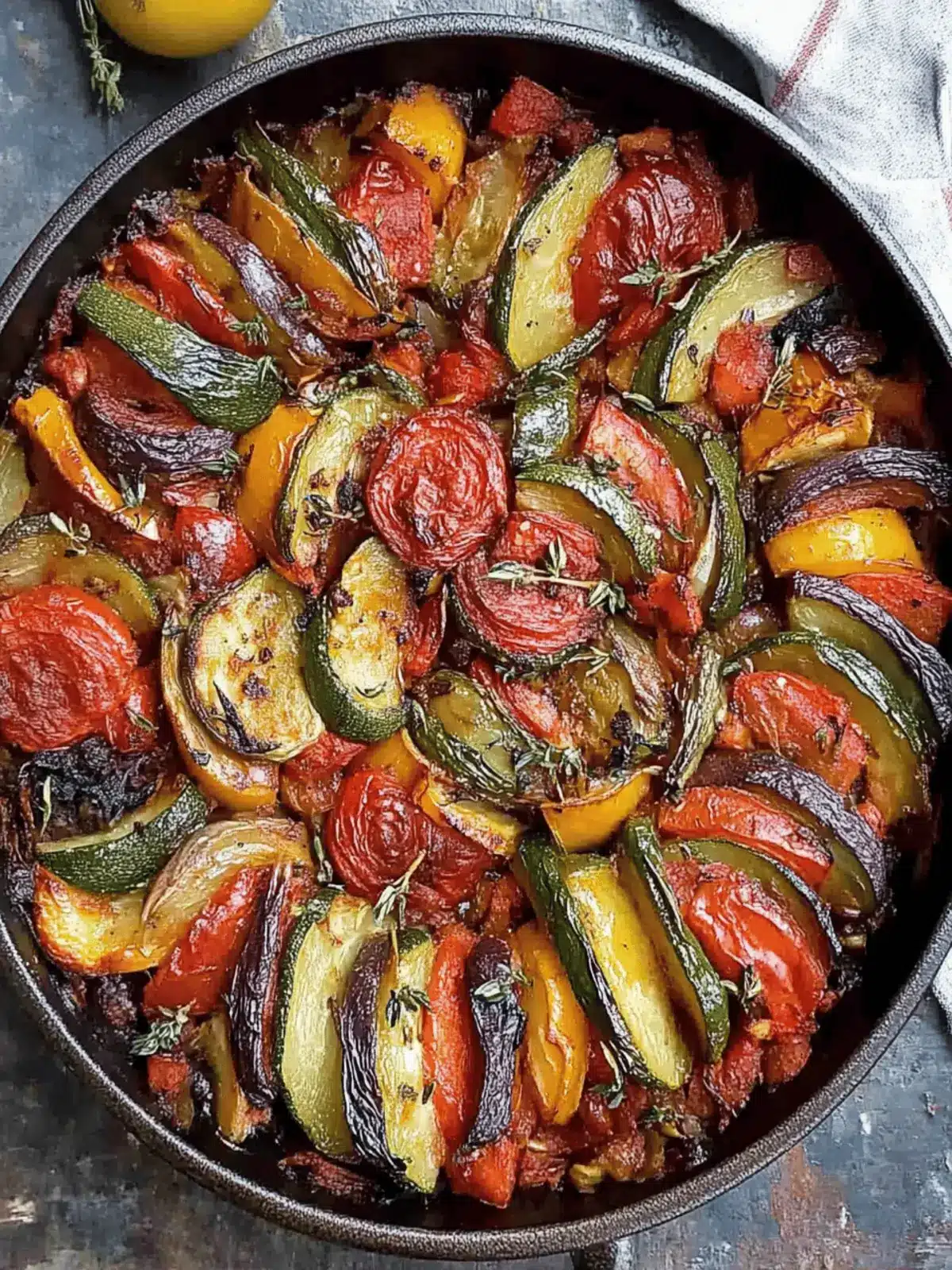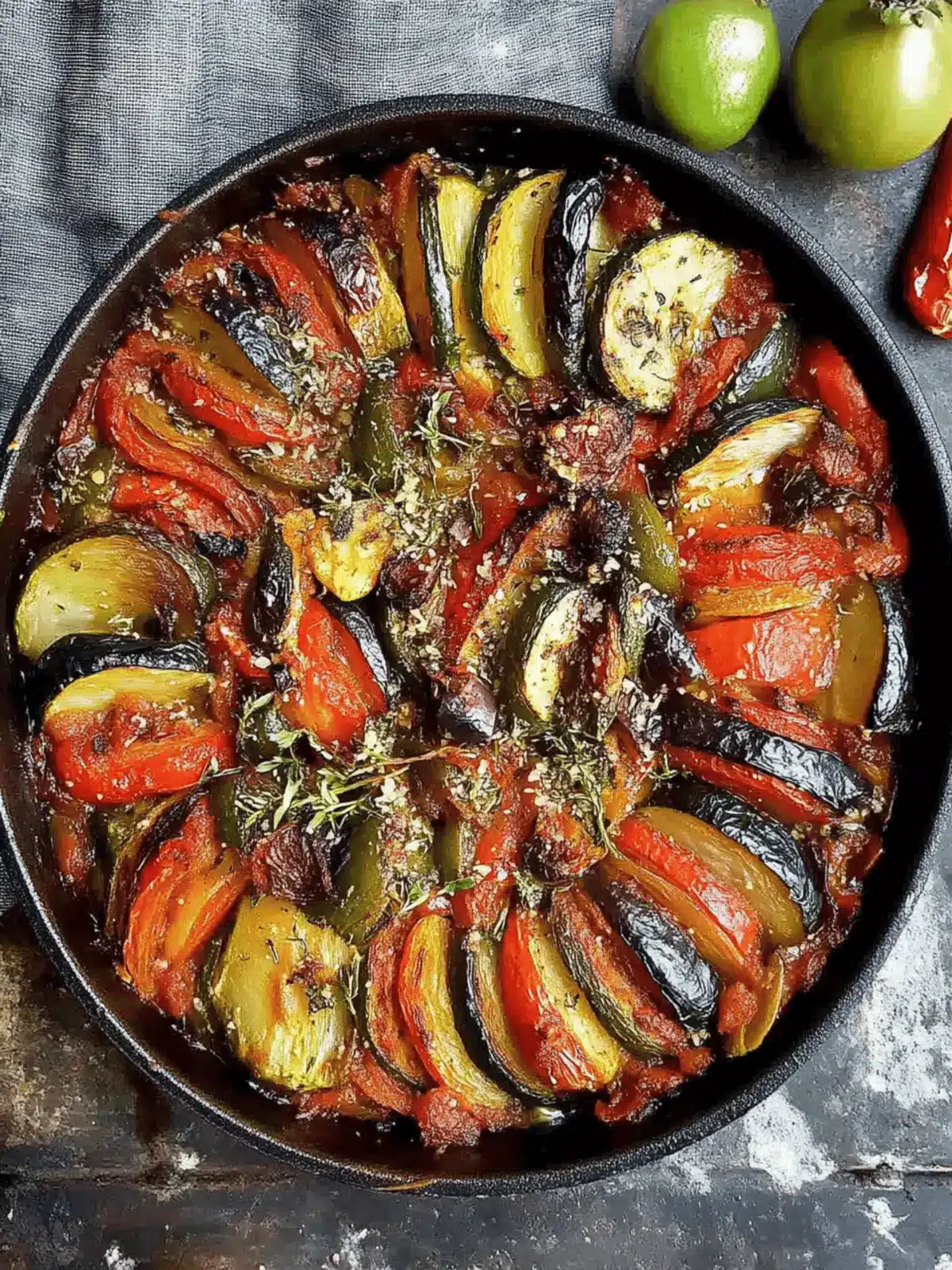There’s something incredibly inviting about the aroma of roasted vegetables wafting through the kitchen. The scent mingles with memories of summer evenings spent at family gatherings, where vibrant plates of Briam—the traditional Greek roasted vegetable dish—served as the star attraction. Imagine a colorful medley of tender potatoes, zucchini, red onions, and tomatoes, all drizzled with fragrant extra virgin olive oil and spiced with Mediterranean herbs. This warm and comforting dish not only excites the senses but is also a celebration of healthy eating—completely vegan and gluten-free!
I first stumbled upon Briam during a quest for a wholesome alternative to the fast food rut I’d fallen into. It quickly became a favorite in my household, and I’m excited to share this recipe with you. Whether you’re looking to impress guests or simply whip up a satisfying weeknight dinner, this easy-to-make Briam will leave everyone craving more, proving that the best meals can often come from the simplest ingredients. Let’s dive into this deliciously effortless recipe that embraces the heart of Greek cuisine!
Why love Greek Roasted Vegetables?
Flavor-packed goodness: Each bite of briam bursts with the vibrant flavors of Mediterranean spices, creating a symphony of taste that elevates any meal.
Freshness matters: Made with fresh, seasonal vegetables, this dish highlights their natural sweetness and texture for a truly wholesome experience.
Easy preparation: Minimal chopping and a straightforward roasting process mean more time to enjoy with loved ones and less time in the kitchen.
Versatile side or main: Whether paired with grilled meats or enjoyed as a vegan focal point, briam fits seamlessly into any dining occasion.
Meal prep friendly: Perfect for make-ahead meals or leftovers, this dish tastes just as delicious reheated, making it a time-saving hero in your weeknight dinner lineup.
Greek Roasted Vegetables Ingredients
For the Vegetable Medley
• Potatoes – Provides structure and heartiness; use waxy varieties for creaminess.
• Zucchini – Adds moisture and a soft texture; feel free to substitute with other squash.
• Red Onions – Contributes sweetness and depth; can be replaced with yellow onions for a milder flavor.
• Diced Tomatoes (canned) – Forms a saucy base and adds acidity; fresh tomatoes can be used instead, just chop and drizzle with olive oil for extra flavor.
For the Dressing
• Extra Virgin Olive Oil (EVOO) – Enhances richness and flavor; opt for darker, more flavorful oils for depth.
• Garlic (fresh) – Offers aromatic flavor; adjust the amount based on your taste preference.
For Seasoning
• Fresh Parsley – Provides freshness and brightness; can be substituted with basil or cilantro if you’re feeling adventurous.
• Oregano – A key herb for authenticity; a mix of dried herbs can work if fresh isn’t available.
• Rosemary (optional) – Adds an earthy flavor; feel free to omit if not preferred.
• Salt and Pepper – Essential for seasoning; adjust to taste for the best balance.
How to Make Greek Roasted Vegetables
-
Preheat the oven to 400°F (200°C). This is the perfect temperature for achieving tender, caramelized vegetables.
-
Slice the potatoes, zucchini, and red onions into thin, even pieces. Aim for consistent sizes to ensure uniform cooking and a delightful texture.
-
Toss the sliced vegetables in a large bowl with salt, pepper, minced garlic, fresh parsley, and a generous drizzle of EVOO. Coat them well—every bite deserves the rich flavors!
-
Layer the diced tomatoes in the bottom of a round baking pan or an oven-safe skillet. This will create a delicious saucy base for the vegetables to roast on.
-
Arrange the vegetable mixture in a circular fashion on top of the tomatoes or simply layer it evenly. Feel free to get creative with the arrangement!
-
Drizzle any leftover olive oil-garlic mixture over the veggies, and add a few more tomatoes on top for extra flavor. This helps ensure every vegetable is packed with zest!
-
Cover the pan with foil in a tent shape, then roast for 75 minutes to lock in moisture. After that, remove the foil and let the vegetables caramelize for an additional 15 minutes until tender and slightly golden.
-
Broil (optional): For an extra charred finish, place under the broiler for a minute or two. Just keep an eye on them to prevent burning!
Optional: Serve with a sprinkle of fresh parsley for a burst of color and flavor.
Exact quantities are listed in the recipe card below.
What to Serve with Greek Roasted Vegetables?
There’s nothing quite like the heartwarming aroma of a delicious meal wafting through your kitchen, especially when it’s accompanied by vibrant sides!
-
Warm Pita Bread: The fluffy texture and slight crispiness of warm pita make it perfect for scooping up tender roasted veggies, enhancing the Mediterranean experience.
-
Tzatziki Sauce: This refreshing yogurt-based dip adds a cool contrast to the warm, roasted flavors of briam, making each bite a delightful combination of tastes.
-
Quinoa Salad: A light, flavorful quinoa toss with cucumbers, tomatoes, and herbs brings a nutritious and textural contrast to the roasted vegetables while staying within the healthy theme.
-
Grilled Lemon Chicken: The zesty, slightly smoky flavor of grilled chicken complements the earthy taste of briam, creating a well-rounded and satisfying meal. Add a squeeze of fresh lemon for brightness!
-
Feta Cheese Crumbles: For those not strictly vegan, a sprinkle of crumbly feta elevates the flavor profile of your briam, adding a salty, creamy touch that beautifully contrasts the sweetness of the roasted veggies.
-
Red Wine: A glass of bold red wine, such as a Greek Agiorgitiko, pairs splendidly with this dish, enhancing the meal with fruity notes that harmonize with the vegetable medley.
-
Lemon Sorbet: To cleanse the palate after such a hearty dish, a refreshing lemon sorbet serves as a light, zesty dessert that beautifully rounds off the meal while echoing the lemony notes present in the briam.
-
Stuffed Grape Leaves: These delectable little bites provide a wonderful stuffed texture, offering flavors of rice, herbs, and spices, making them a delightful complement to the roasted vegetable dish.
Expert Tips for Greek Roasted Vegetables
-
Uniform Slicing: Ensure that vegetables are sliced evenly to promote uniform cooking. This will help prevent some pieces from being mushy while others remain crunchy.
-
Marinating Time: Allow the vegetables to sit in the olive oil and seasoning mixture for at least 30 minutes before roasting. This extra time enhances the flavor of your Greek roasted vegetables.
-
Layering Vegetables: When layering in the baking dish, try to avoid overcrowding. A single layer will ensure that the vegetables roast evenly instead of steaming.
-
Tomato Base: Using canned diced tomatoes creates a wonderful, saucy bed for the vegetables. If using fresh, add a bit of olive oil and salt to help release their juices.
-
Storage Tip: Leftovers can be stored in an airtight container for up to 5 days. To maintain the moisture and flavor, reheat gently with a splash of water in the microwave or on the stove.
Make Ahead Options
Preparing Greek Roasted Vegetables in advance is a fantastic way to save time during busy weeknights! You can slice the potatoes, zucchini, and red onions up to 24 hours ahead and store them in an airtight container in the refrigerator, tossed with a bit of olive oil to prevent browning. The diced tomatoes can also be placed in your baking dish ahead of time. When you’re ready to cook, simply layer the sliced vegetables over the tomatoes and follow the roasting instructions. This method ensures a fresh, flavorful dish that’s just as delicious reheated, making it a perfect addition to your meal prep routine!
Greek Roasted Vegetables Variations
Feel like custom-blending this delightful dish? Here are some fun ways to elevate your Greek Roasted Vegetables!
-
Add Eggplant: Slice and layer eggplant for a richer texture and flavor, further enhancing the Mediterranean experience.
-
Sweet Bell Peppers: Incorporate colorful bell peppers to add a sweet crunch and vibrant color—perfect for making your dish pop!
-
Cauliflower Swap: For a lower-carb version, replace potatoes with cauliflower or cauliflower rice, which brings a wonderful nutty flavor.
-
Spice it Up: Sprinkle in some red pepper flakes for a warm kick, giving your roasted vegetables an exciting zesty finish that enhances every bite.
-
Kalamata Olives: Toss in Kalamata olives before serving to introduce a salty, briny contrast that complements the sweetness of the roasted veggies.
-
Feta Cheese Finish: Crumble some feta cheese on top just before serving for a creamy, tangy burst that beautifully ties in with the Mediterranean flavors.
-
Herb Variations: Swap fresh parsley for basil or cilantro for a different herbal twist, or add thyme for an aromatic note that pairs wonderfully with the roasted veggies.
-
Zesty Lemon Drizzle: Just before serving, add a squeeze of fresh lemon juice to brighten up the flavors, enhancing the freshness of your dish!
How to Store and Freeze Greek Roasted Vegetables
Fridge: Store leftover Greek roasted vegetables in an airtight container for up to 5 days. Make sure they are completely cool before sealing to prevent moisture buildup.
Freezer: For longer storage, freeze the roasted veggies in a single layer on a baking sheet, then transfer to a freezer-safe bag. They can last up to 3 months.
Reheating: When ready to enjoy, thaw the frozen vegetables overnight in the fridge. Reheat gently in a microwave or on the stove with a splash of water to keep them moist.
Make-ahead: You can prepare the dish a day in advance; simply store it in the fridge after cooling and reheat to savor the delicious flavors again!
Greek Roasted Vegetables Recipe FAQs
How do I select the right vegetables for Briam?
Absolutely! For the best results, choose fresh, seasonal vegetables. Look for potatoes that are firm and without dark spots, zucchini should be glossy with no blemishes, and red onions should feel heavy with a crisp outer layer. Fresh tomatoes can either be ripe or slightly under ripe.
What’s the best way to store leftover Greek roasted vegetables?
Store any leftover Greek roasted vegetables in an airtight container in the refrigerator for up to 5 days. Make sure they have completely cooled before placing them in the container to avoid excess moisture, which can lead to sogginess.
Can I freeze Greek roasted vegetables?
Certainly! To freeze, allow the vegetables to cool completely and then spread them in a single layer on a baking sheet. Freeze until solid (about 1-2 hours) and then transfer them to a freezer-safe bag. They will last for up to 3 months.
What should I do if my roasted vegetables are too soggy?
If you find your roasted vegetables turning out soggy, it could be because they were overcrowded in the pan or had excess moisture. Ensure you use a single layer when baking to promote roasting rather than steaming. If they do become soggy, briefly broiling them at the end can help caramelize them and give a texture boost!
Is there a way to make Briam more allergen-friendly?
Very much so! This dish is already vegan and gluten-free, but if you’re concerned about other allergens, stick to certified gluten-free canned tomatoes and make sure the olive oil is pure. Additionally, watch out for common allergens in herbs or any extras you choose to add, like olives or cheese.
How long can I prepare Briam in advance?
I often make this dish a day in advance. Just prepare all the ingredients, layer them in the baking dish, and cover it tightly with foil. Store it in the fridge until you’re ready to bake! When it’s time, just pop it into the oven and follow your roasting instructions for a fresh, delicious meal ready to serve!

Greek Roasted Vegetables Perfectly Flavored for Your Table
Ingredients
Equipment
Method
- Preheat the oven to 400°F (200°C).
- Slice the potatoes, zucchini, and red onions into thin, even pieces.
- Toss the sliced vegetables in a large bowl with salt, pepper, minced garlic, fresh parsley, and a generous drizzle of EVOO.
- Layer the diced tomatoes in the bottom of a round baking pan.
- Arrange the vegetable mixture in a circular fashion on top of the tomatoes.
- Drizzle any leftover olive oil-garlic mixture over the veggies, and add a few more tomatoes on top.
- Cover the pan with foil in a tent shape, then roast for 75 minutes. Remove the foil and let the vegetables caramelize for an additional 15 minutes.
- Broil (optional) for an extra charred finish.








